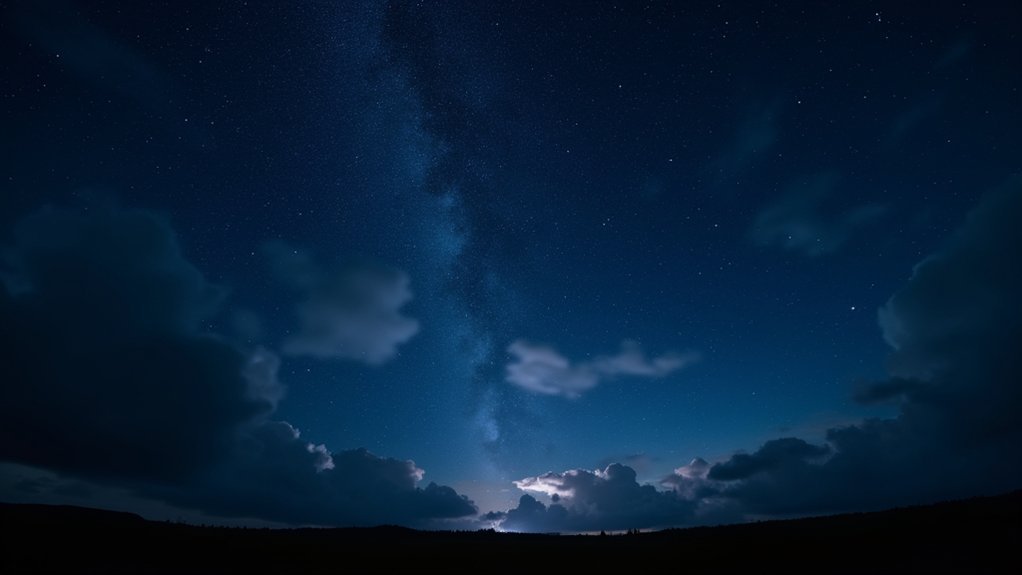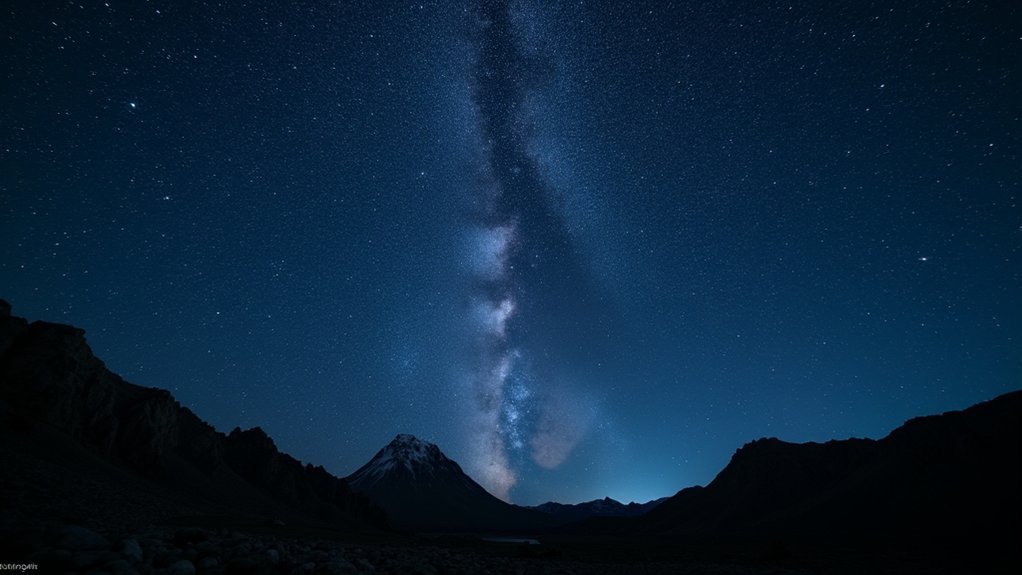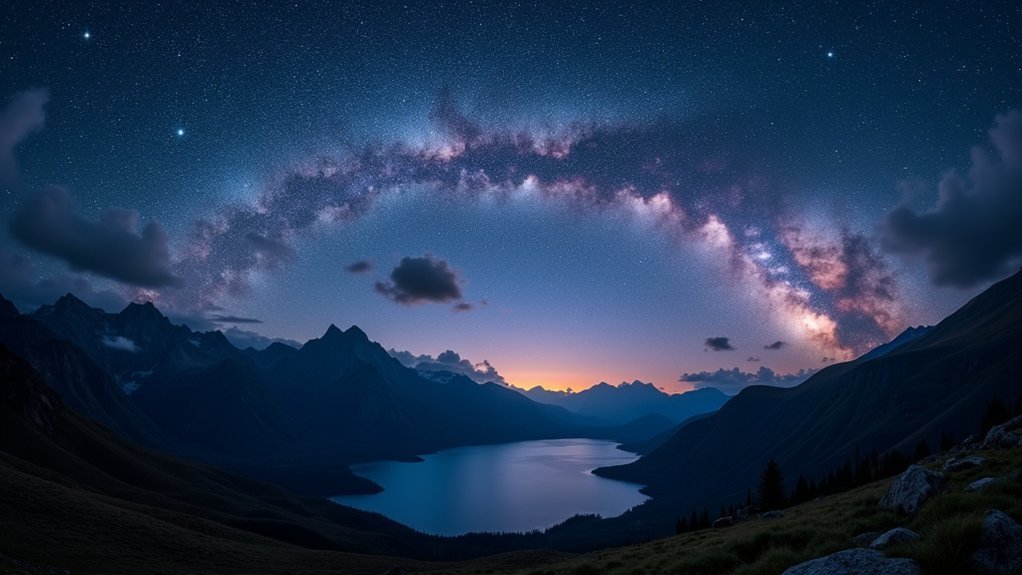For amazing star photos, use the 500 Rule to determine your maximum shutter speed: divide 500 by your lens’s focal length. With a 24mm lens on a full-frame camera, you’d need about 20 seconds. For crop sensors, first multiply your focal length by the crop factor (1.5x or 1.6x). Pair this with a wide aperture (f/2.8 or wider) and ISO between 1600-6400. The perfect settings vary by equipment, but these guidelines will set you on the path to capturing stunning night skies.
Understanding the 500 Rule for Star Photography

One essential formula guides most beginner astrophotographers: the 500 rule. This simple calculation—500 divided by your lens’s focal length—gives you the maximum shutter speed in seconds before stars begin to trail across your image.
The 500 rule offers astrophotography novices a straightforward way to calculate optimal exposure times and prevent unwanted star trails.
For example, with a 24mm lens on a full-frame camera, you’d use a maximum exposure of about 20 seconds (500 ÷ 24 = 20.8).
If you’re shooting with a crop sensor, remember to multiply your focal length by the crop factor first. A 24mm lens on an APS-C Nikon (1.5× crop) effectively becomes 36mm, limiting you to about 14 seconds.
The 500 rule works best with wide-angle lenses under 50mm and provides a reliable starting point for static tripod setups without star trackers. Some photographers now prefer the Rule of 300 for cameras with crop sensors, as it typically yields sharper star images when viewed at higher magnifications.
Optimal Shutter Speed Ranges for Different Focal Lengths
Wide angle lenses offer you a significant advantage when shooting stars, typically allowing for longer exposures before star trails become noticeable.
You’ll find that applying the 500 Rule at focal lengths like 14mm lets you shoot at around 35 seconds, while a 50mm lens restricts you to just 10 seconds before stars begin to streak.
These longer available exposures with wide angles help you capture more light and detail in the night sky while maintaining those pinpoint stars that create such striking astrophotography.
However, for absolute precision, consider using the NPF Rule which accounts for your camera’s pixel size and other lens characteristics that the simpler 500 Rule doesn’t address.
Wide Angle Advantages
When capturing the night sky, wide-angle lenses offer distinct advantages that can greatly enhance your astrophotography results.
They capture more of the celestial canvas while being forgiving with camera movement, making them perfect for beginners and experts alike.
- Broader field of view – You’ll fit more stars, constellations, and landscape elements in a single frame, creating more dramatic compositions.
- Greater stability – Wide-angle lenses (14-24mm) allow you to use slightly slower shutter speeds without noticeable blur compared to telephoto options.
- Composition flexibility – You can include foreground elements like mountains or trees alongside the star-filled sky for more compelling images.
- Movement forgiveness – Even slight camera shake is less apparent with wider lenses, giving you a better chance at sharp images even in challenging conditions.
For standard star photography, a 10 to 30 seconds exposure time is ideal to capture stars as points of light rather than creating star trails.
500 Rule Applications
Understanding how to apply the 500 Rule lets you determine the best shutter speed for capturing sharp stars without unwanted trailing.
Simply divide 500 by your full-frame lens’s focal length to find your maximum exposure time.
For common lenses, you’ll get approximately:
- 14mm: 35 seconds
- 16mm: 31 seconds
- 20mm: 25 seconds
- 35mm: 14 seconds
In practice, you might want to use slightly shorter exposures than calculated for sharper stars.
Many photographers prefer 20-25 second exposures with wide-angle lenses for the best results. When using a wider aperture like f/2.8 or f/4, you can capture more light while maintaining optimal shutter speeds for crisp star images.
If you’re seeking even sharper stars, consider the 400 Rule or 300 Rule as alternatives.
These provide shorter exposure times and can be particularly useful for crop-sensor cameras where star trailing becomes more apparent.
How Camera Sensor Size Affects Your Shutter Speed Choices

Your camera’s sensor size greatly impacts the shutter speeds you’ll need for sharp star photos.
With APS-C sensors, you must account for the crop factor (typically 1.5x or 1.6x) when calculating your maximum shutter speed, effectively requiring faster speeds than full-frame cameras using the same lens.
For example, a 20mm lens on an APS-C camera with a 1.5x crop factor acts like a 30mm lens, meaning you’d need to shoot at 1/30s instead of 1/20s to avoid star trails.
Modern image stabilization technologies can allow you to use slower shutter speeds than traditionally recommended while still maintaining sharp star images.
APS-C vs. Full-Frame
The camera sensor you choose plays an essential role in determining ideal shutter speeds for star photography. Full-frame sensors typically allow longer exposures before noise becomes problematic, giving you more flexibility when capturing the night sky.
When deciding between APS-C and full-frame for star photography, consider:
- Signal-to-noise advantage – Full-frame offers 1.2-1.4 stops improvement, letting you use longer exposures or higher ISOs with less noise.
- Dynamic range benefits – Larger sensors capture more light information, preserving both bright stars and dark sky details.
- ISO performance – Full-frame maintains quality at higher ISOs, vital for capturing faint celestial objects.
- Cost considerations – APS-C provides good results at lower price points, making star photography more accessible. The more compact and lightweight APS-C cameras are also advantageous for night photography expeditions requiring travel to remote locations.
Crop Factor Calculations
Beyond the sensor type itself, understanding the mathematics behind crop factors will sharpen your star photography considerably.
These multipliers (typically 1.5x-1.6x for APS-C and 2x for Micro Four Thirds) adjust both your field of view and effective shutter speed requirements.
When calculating maximum exposure times for star photos, you’ll need to apply the crop factor to your focal length first.
For instance, a 16mm lens on an APS-C camera (1.5x crop) behaves like a 24mm on full-frame, requiring shorter exposures to prevent star trails.
Using the adjusted 500 Rule: divide 500 by your full-frame equivalent focal length (500/(16×1.5) = ~21 seconds).
Remember that higher-resolution crop sensors demand even faster speeds—a 32MP APS-C camera might need speeds 1.3× faster than a 20MP model.
The interrelationship between aperture and shutter speed becomes critical in astrophotography, as a larger aperture allows you to use shorter exposure times while still capturing enough light from distant stars.
Balancing Shutter Speed With Aperture and ISO for Night Skies
Achieving perfect night sky images requires mastering the delicate interplay between shutter speed, aperture, and ISO settings.
The celestial canvas demands a photographer’s precision in balancing exposure elements for breathtaking astronomical captures.
You’ll need to balance these factors based on your equipment capabilities and environmental conditions to capture clear, detailed star photos.
- Start with a wide aperture (f/2.8 or wider) to maximize light collection, allowing you to keep shutter speeds shorter and reduce star trails.
- Set your ISO between 1600-6400 depending on your camera’s noise handling capabilities.
- Adjust shutter speed to 15-25 seconds to capture star detail without trailing, considering your focal length. For precise calculations, use the 500 Rule to determine the maximum shutter speed based on your lens.
- Fine-tune your settings through experimentation – increase ISO when needed, but maintain the widest possible aperture to optimize light capture.
Preventing Star Trails With Precise Timing Techniques

Star trails can ruin an otherwise perfect night sky photograph, requiring you to master precise timing techniques that account for Earth’s rotation. The 500 Rule offers a simple solution: divide 500 by your focal length to find your maximum shutter speed in seconds. For even sharper stars, try the 450 Rule instead.
Remember to adjust for your camera’s crop factor by multiplying your focal length accordingly before applying these formulas. Wide-angle lenses give you more flexibility with longer exposures, while telephoto lenses demand faster shutter speeds. Viewing context significantly affects acceptable amounts of trailing, as slightly trailed stars might be unnoticeable on web images but very apparent in large prints.
If you’re still catching trails, consider stacking multiple short exposures instead of one long shot. Use a stable tripod, remote release, and pre-focus on a bright star before switching to manual focus to guarantee pin-sharp results.
Field-Tested Shutter Speed Settings for Common Lenses
When you venture into the field with your camera pointed skyward, knowing the exact shutter speed for your specific lens can make all the difference between capturing pinpoint stars or creating accidental star trails.
Apply these field-tested settings to your favorite focal lengths for ideal results:
- Wide-angle (14-24mm): Use 20-25 seconds with the 500 rule (500÷focal length). Perfect for capturing vast starscapes with minimal trailing.
- Standard (35-50mm): Limit exposure to 10-15 seconds. Remember to use the 400 rule for a more conservative approach that guarantees sharper stars.
- Telephoto (85-135mm): Keep shutter speeds between 4-8 seconds to avoid motion blur from Earth’s rotation. Fast aperture lenses with f/2.8 or wider capabilities are particularly valuable at these focal lengths.
- APSC sensors: Always multiply your focal length by 1.6 before applying any rule, as your crop factor greatly affects exposure times.
Frequently Asked Questions
Can Tracking Mounts Eliminate Shutter Speed Limitations Entirely?
No, tracking mounts don’t entirely eliminate shutter speed limitations. While they counter Earth’s rotation, you’ll still face constraints from mount accuracy, wind vibration, atmospheric conditions, and your equipment’s weight capacity limitations.
How Do Atmospheric Conditions Affect Optimal Shutter Speed Settings?
Atmospheric conditions directly impact your ideal shutter speed choices. In hazy air, you’ll need shorter exposures to minimize distortion, while clear skies allow longer exposures. Light pollution, cloud cover, and temperature also affect your settings considerably.
Do Smartphone Cameras Work for Astrophotography?
Yes, you can use smartphones for astrophotography, especially newer models like the Pixel 9 and Galaxy S24 Ultra. You’ll need a tripod and dark skies, but their dedicated night modes capture impressive star photos.
How Does Light Pollution Change Recommended Shutter Speeds?
Light pollution doesn’t change your recommended shutter speeds for star photography. You’ll still use the same speeds to avoid trails, but you’ll need to adjust your ISO instead of extending exposure time.
Can Image Stacking Replace Longer Exposure Times?
No, stacking can’t fully replace longer exposures. You’ll need both—adequate individual exposures to capture faint details and stacking to reduce noise. They’re complementary techniques rather than substitutes for quality astrophotography.
In Summary
You’ve now got all the tools to nail your star photography. Remember to apply the 500 rule, adjust for your sensor size, and balance your settings appropriately. Whether you’re shooting with a wide-angle or telephoto lens, the right shutter speed makes all the difference. Don’t be afraid to experiment—your perfect settings may vary slightly based on conditions. Now get out there and capture the cosmos!





Leave a Reply